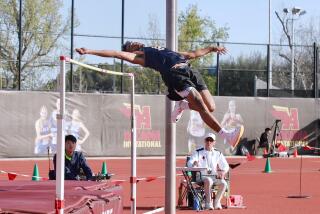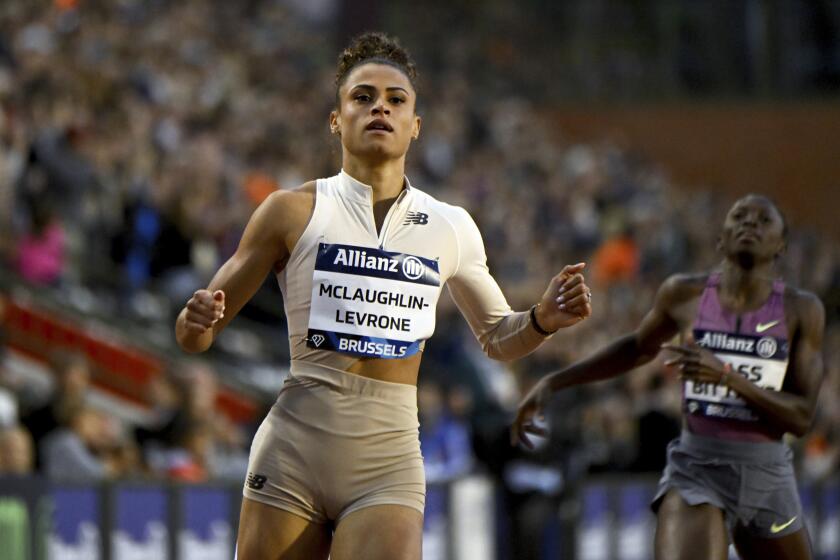One, Two, Three, Leap . . . : Simpkins Is the Latest in Talented New Group of Triple Jumpers
- Share via
An intriguing thing about track and field is that are always new barriers to overcome.
In the 1950s, it was the sub-four-minute mile, and when Britain’s Roger Bannister broke through in 1954, a parade of runners soon followed him.
There are new barriers in the ‘80s, all neat, even figures: the 8-foot high jump, 30-foot long jump, 20-foot pole vault and 60-foot triple jump.
“It’s going to be a race to see who gets to 60 feet first,” said Willie Banks, the world record-holder at 58-11 1/2.
Banks, 29, the elder statesman of the event, is the likely choice to reach 60 feet before anyone else, based on his accomplishments and experience.
But Banks is looking warily at a relative newcomer, Charlie Simpkins, 22, whose improvement curve is startling.
Virtually unknown until 1985, Simpkins, a 6-foot 1-inch, 156-pound athlete from Aiken, S.C., became the No. 3 triple jumper of all-time, bounding to 58-7 in the World University Games last September at Kobe, Japan.
That achievement, as impressive as it was, didn’t provide Simpkins instant recognition. After all, he recorded his mark at the end of the outdoor track season and in a foreign country.
Simpkins got some attention, though, when he broke Banks’ indoor record with a jump of 57-5 last month in the Sunkist Invitational at the Sports Arena.
It was accomplished in dramatic fashion, on his last attempt, allowing him to beat Mike Conley, who was already established as a world-class performer in the triple and long jumps.
Simpkins will compete against Conley again in the Times/GTE Indoor Games Friday night at the Forum and also at the Michelob Invitational Sunday afternoon in San Diego.
Banks is a spectator this indoor season. An aspiring lawyer, he will take the California Bar examination for the fourth time next week, a barrier that has been more difficult than any world record.
Simpkins was content to play basketball in high school and had no interest in track and field until a friend suggested that he consider jumping someplace other than a gym.
“A friend saw me dunking a basketball and asked me to come out for track,” Simpkins said. “I did a little high jumping and long jumping and he said, ‘Why don’t you try to triple jump?’ After I learned how to do it, I beat him.
“Now it’s my favorite event because it’s the thing I do best.”
Simpkins was so naive about the event that he sometimes jumped in basketball shoes with no tongues. Even so, he won the triple jump at the state meet in his senior year with a leap of 49-11.
Howard Bagwell, athletic director at small Baptist College in Charleston, S.C., had been aware of Simpkins’ potential early and had recruited him for the school.
Simpkins jumped 54-7 as a freshman, finishing fifth in the NCAA meet in 1983. He improved to 55 feet in 1984 and moved up to third in the NCAA meet. He also finished fifth in the U.S. Olympic trials when Ray Kimble took fourth place away from him on his last jump.
“We, meaning the jumpers, knew who Simpkins was,” Banks said. “He was coming up.”
But except for track elitists, no one else was really aware of him.
Simpkins didn’t compete for Baptist College last year and was only a footnote at the TAC meet in Indianapolis. Banks won with his world-record jump of 58-11 1/2, and Conley was second at 58-1. Simpkins finished third at 57-5 3/4 with the finest six-jump series ever, an average of 57 feet.
Then, he joined the 58-foot club in Japan and subsequently beat Conley for the first time with his indoor world record at the Sunkist meet.
“I had one jump left, and if I didn’t do it, I would lose,” Simpkins recalled. “I was determined to win, and everything had to be perfect.”
Mark Embler, a therapist in Charleston and a former cross-country coach at Baptist College, is Simpkins’ adviser and part-time coach.
“But Charlie does a good job of coaching himself,” Embler said. “He has studied the techniques of other jumpers with video tapes and is working with weights to get stronger. He has a tremendous amount of spring and high jumped 7-2 in a dual meet last year. He has never been a sprinter but, if he trained, he would be a good sprinter.”
Banks has been critical of Simpkins’ form in the past and told Track & Field News after the TAC meet: “I’ve never seen a person with such bad technique jump so far in my life.”
But Banks also says that Simpkins’ first two phases, the hop and step, are the best of anyone’s, sometimes carrying him almost to the landing pit.
“His problem is that he doesn’t take his last phase, the jump, out as long as I do.” Banks said, “And he holds back rather than taking his hop-step phase to its fullest potential.
“I don’t want to tell him the secret because he might beat me. But if he would hop-step into the pit, people would make the distance between the board and the pit longer so that he could get a longer hop-step and he could go 60 feet.”
Said Simpkins: “If I land in the pit (after the hop-step), there’s a great chance I would get hurt. I wish they would move the board back from the pit. I would feel more comfortable.”
Will Kern, meet director of the Times/GTE meet, said that Simpkins will be accommodated in this regard.
Banks bounces like a kangaroo down the runway. Conley, an accomplished sprinter, doesn’t get much height and scurries like a road runner. Banks said that Simpkins’ overall style is close to his.
“Charlie is lighter than I am and more nimble,” Banks said. “The only thing I have on him is my longer jump phase and my years of competing. If he had as many years as myself, he would be in my position and he’s trying take over my position.”
Simpkins isn’t competing for Baptist College this year. The school is on NCAA probation and Simpkins is representing a shoe company.
“Baptist is not going to any big meets and I have better opportunities not jumping for the school,” Simpkins said. “If we had the nationals, it would be different. But now I can get some early recognition.”
Simpkins has brought some recognition to Aiken, S.C., but he isn’t the city’s most famous citizen. That distinction goes to William (The Refrigerator) Perry of the Chicago Bears, Simpkins’ high school teammate.
“He’s a really nice person,” Simpkins said of Perry. “He threw the shot and discus for us. We would all go to McDonald’s, and I don’t remember how much he ate, but he ate a lot.”
Simpkins is the latest star in an event that had a resurgence in 1985 after stagnating for many years.
Brazil’s Joao Oliveira put the record out to 58-8 1/2 at high altitude in 1975 and no one else was even in the 58-foot range until last year.
Banks opened the door and others followed. Simpkins, Conley, Bulgaria’s Khristo Markov and the Soviet Union’s Oleg Protsenko all became 58-foot jumpers.
“It took someone to jump it,” Banks said. “The talent was there. I couldn’t believe that someone hadn’t done it. Now, I think 60 feet should be easy.
“They didn’t make the triple jump a legitimate event in some high schools until 1973. It took 10 years to develop the techniques. Coaches have now studied the event, so they’re teaching athletes at a younger age how to get out farther.
“That’s why you have seen the great surge and you’ll see another surge this year. You’ll see the same thing happen to the women. In 10 years they’ll be jumping 52 and 53 feet.”
But no one improved more than Simpkins, who exceeded his personal best by more than three feet.
“When somebody else does it (58 feet), it doesn’t look as hard or seem as far,” he said. “I would have liked to have been the person who did it, instead of having had it done to me. Now I would like to be the first person to jump 59 feet--or farther.”
More to Read
Go beyond the scoreboard
Get the latest on L.A.'s teams in the daily Sports Report newsletter.
You may occasionally receive promotional content from the Los Angeles Times.







